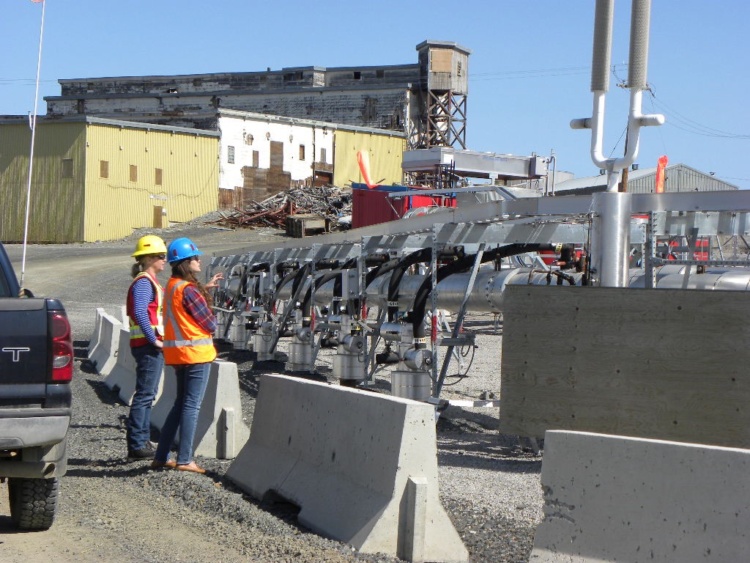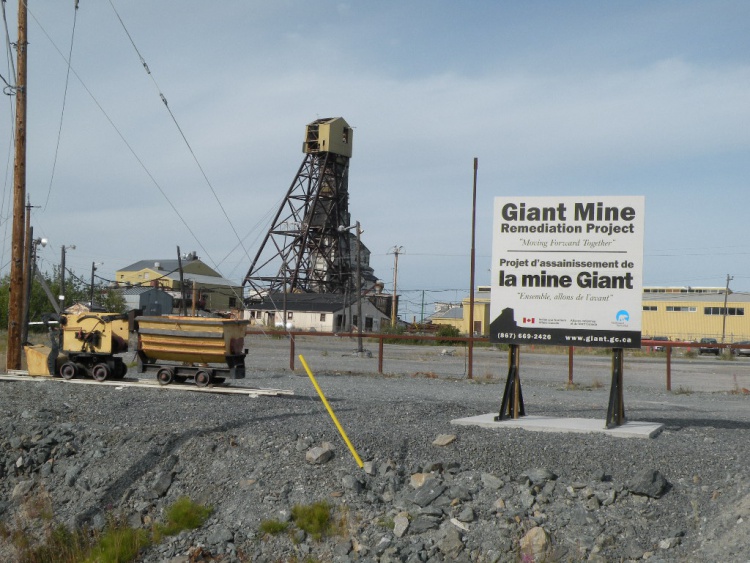Mine remediation entails long-term risks due to the need to contain and monitor dangerous materials. To date, research on mine remediation in Canada has focused primarily on technical fixes; little is known about the political and social nature of remediation. Using the Giant Mine in Yellowknife, NWT as a case study, my thesis analyzes mine remediation in the Canadian sub-Arctic and investigates how local communities shape remediation processes. Throughout the interviews I conducted for my research the buried arsenic contamination at the Giant Mine was often referred to as an underground ‘monster.’ Using the monster metaphor, this research investigates the story of the creation of the Giant Mine Monster: how it was defined, how it has changed, and how the community will care for the Monster in the future.
In 2007 a remediation plan was published by the Giant Mine Remediation Project Team that featured the ‘frozen block method’ as the best option for arsenic remediation at the Giant Mine. This plan required that the site be frozen, monitored, and maintained in perpetuity. Many community members were unsatisfied with this remediation plan and the Yellowknives Dene First Nation and Alternatives North, a social justice NGO in the NWT, petitioned the City of Yellowknife to request an environmental assessment of the remediation plan. The environmental assessment, completed in 2013, led to the signing of the Giant Mine Remediation Project Environmental Agreement in June 2015. This agreement is a legally binding document that holds the federal and territorial governments responsible to ensure community involvement and consent in future remediation planning. This agreement also resulted in the creation of the Giant Mine Oversight Board.

Master’s student Caitlynn Beckett visits the Giant Mine remediation test site in Yellowknife.
My research began by investigating why community stakeholders rejected the 2007 remediation plan, despite government arguments that the remediation plan did not present any cause for concern. I then analyzed how community stakeholders redefined the Giant Mine Remediation Project throughout the Environmental Assessment and Environmental Agreement processes. Applying the concepts of ecological restoration, environmental justice, social waste theory, and theories of repair, and care, I argue that remediation projects such as the Giant Mine often fail to secure public trust and can perpetuate systems of injustice and disenfranchisement if they overlook local knowledge and community concerns. In addition, technical remediation plans often fail to address the complexities of perpetual care of contaminated sites. However, The Giant Mine case also illustrates the potential for community activism to shift remediation in order to confront environmental injustices and to care for people and the environment through reconciliation and intergenerational equity. Rethinking remediation projects alongside community-based concerns, perpetual care and reconciliation offers creative opportunities to redefine and repair damaged spaces and relations.
Publications
Caitlynn’s community research report: “Rethinking remediation at Giant Mine.”
Beckett, C. 2020. “Beyond remediation: Containing, confronting and caring for the Giant Mine Monster,” Environment and Planning E: Nature and Space, doi.org/10.1177/2514848620954361.
Beckett, C., and Keeling, A. 2019. “Rethinking Remediation: Mine reclamation, environmental justice, and relations of care,” Local Environment 24,3: 216-230
Beckett, Caitlynn. 2017. Rethinking remediation: mine closure and community engagement at the Giant Mine, Yellowknife, Northwest Territories, Canada. Masters thesis, Memorial University of Newfoundland
Beckett, Caitlynn. 2018. Rethinking Remediation at the Giant Mine, Yellowknife: Who decides what is ‘clean enough’? Blog post in NiCHE Seeds 2.0: New Research in Environmental History.
Sandlos, J., and Keeling, A. 2016. Aboriginal Communities, Traditional Knowledge, and the Environmental Legacies of Extractive Development in Canada. The Extractive Industries and Society 3,2:278-287.
